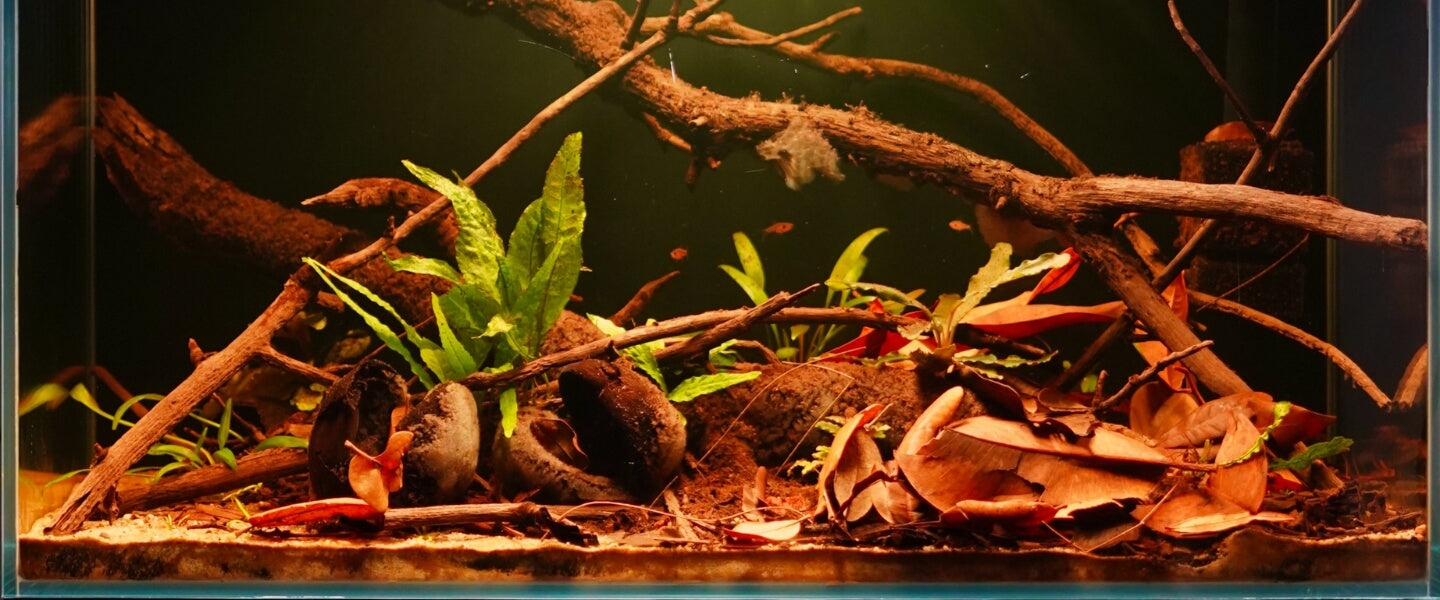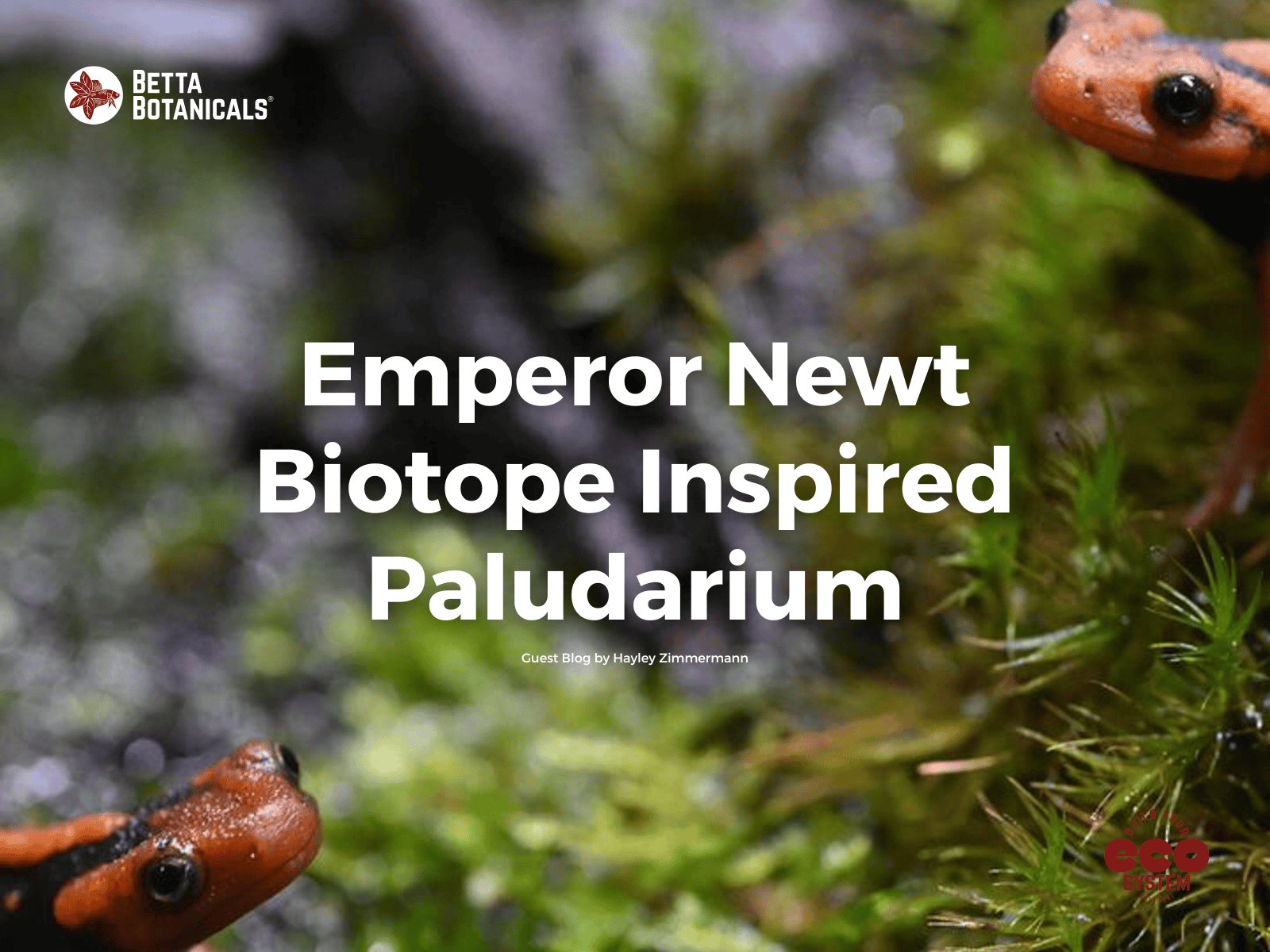Aquarium enthusiasts should continuously seek innovative ways to replicate nature’s intricacies while fostering functional and easy-to-maintain ecosystems. A “dirted” botanical method aquarium, also known as a dirted tank with botanicals, combines two impactful approaches: nutrient-rich ‘functional’ soil substrates for plant growth and the integration of botanicals to simulate nature's processes. This method not only provides the foundation for thriving aquatic life but also mimics the processes and appearances of wild aquatic ecosystems. As a natural planted tank alternative, one thing is clear: a Botanical Method Aquarium and a Walstad Plant Tank are not the same things… but they do share many similar methods!
Disclaimer: This blog post assumes you are familiar with the basics of maintaining a botanical method aquarium. This information can be found here: The Botanical Method Aquarium
The photography in this blog post was kindly provided in collaboration with our #tanninbae ambassador, Brandy, who can be found on Instagram at @brandys_bettas

This mature blackwater aquarium showcases the power of a dirted substrate layered with botanicals, creating a thriving, self-sustaining aquatic ecosystem.
What Is a Walstad Method Dirted Aquarium?
A “dirted” aquarium, rooted in Diane Walstad’s “Natural Planted Tank” methodology, utilizes terrestrial soil capped in sand or fine gravel as the primary substrate. This soil serves as a long-term source of essential nutrients for plants and a home for a diverse population of bacteria, thus enabling a natural cycle in which plants contribute to water filtration while benefiting from the organic waste produced by fish and invertebrates. Over time, this interaction of plants and a structured substrate helps create a stable and self-sustaining environment that really only needs water top-offs with RODI and the occasional plant pruning.
The botanical method aquarium has many similarities to Diana’s approach, but with a few key differences, such as incorporating natural materials like dried leaf litter, seed pods, needles, and bark, which release tannins, humic substances, and trace nutrients into the water. These compounds alter the water’s chemistry and provide ecological benefits, such as supporting microbial life and fostering the development of biofilms, essential components of aquatic food webs. More so, these functional aesthetics change the behaviors of the fish, allowing them to behave more like we would experience in nature. These methods belong to a growing movement of aquarists who believe aquariums should evolve like nature.

This Southeast Asian blackwater habitat offers a glimpse into the wild ecosystems that inspire blackwater aquariums—shallow, tannin-rich water filled with leaves and aquatic vegetation.
Nature as a Blueprint: Lessons from South America & Southeast Asia
As These Methods Apply in a South American Ecosystem
In South American blackwater habitats, such as the Rio Negro and Orinoco basin, leaf litter, fallen branches, and decomposing plant material cover the forest floor. These layers allow for the creation of an acidic, often nutrient-poor environment, where the water’s tannin content darkens its appearance and alters its chemical makeup. Mimicking these habitats in a dirted botanical method aquarium involves using materials like Cacao Leaves, Guava Leaves, Casho Leaf Litter, with pods like Cariniana, Savu (releasing 2025), and our huge Sapucaia Pods. These natural botanicals release organic compounds into the water and aid in its stabilization through the reintroduction of humic substances, compounds removed in order to create safe drinking water.

Neon Tetras thrive in the subdued light and complex structure of this blackwater aquarium.
South American fish, such as tetras, corydoras, and ivanacara bimaculata, thrive in these setups because the leaf litter provides hiding spots, supports spawning behavior, and fosters microfauna that serve as supplemental nutrition between feedings. Despite their geographical distance, South America and Southeast Asian environments show us how organic substrates and decaying botanicals contribute to thriving ecosystems.
Inspired by Southeast Asian Peat Swamps
Southeast Asian blackwater streams, like those in Borneo or the Sundaland region, similarly host complex ecosystems dominated by botanical materials and sedimented substrates. Cryptocoryne plants and Bucephalandra plants, iconic to this region, thrive in shaded, tannin-rich waters where water column nutrient availability is limited. These plants are naturally adapted to the conditions provided by submerged botanicals, making them ideal for a dirted botanical method aquarium.
Adding botanicals like Terentang Leaves, Macaranga Leaves, or Jambolan Leaves with Catappa bark can replicate the slow decomposition and nutrient release found in Southeast Asian habitats. This approach recreates an environment as we would find in nature, appearing and functioning exactly as our fish evolved to coexist in.

Detritus and biofilms form on botanicals in a dirted blackwater aquarium, providing vital nourishment for microfauna while supporting substrate ecology.
The Benefits of a Dirted Botanical Method Aquarium
- Enhanced plant growth: The nutrient-rich soil acts as a natural fertilizer, supplying plants with essential minerals and trace elements. This eliminates the reliance on fertilizer supplements while supporting sustained growth for species like Amazon Swords and Cryptocoryne, which thrive in substrates that mimic their natural environments.
- Natural habitat replication: Combining soils and botanicals allows aquarists to recreate environments such as the leaf-strewn igapó forests of the Amazon or the root-laden blackwater streams of Southeast Asia. These setups mirror the physical appearance and function of these habitats, including substrate composition and organic layers of the ‘perpetual substrate’.
- Improved water chemistry: Botanicals contribute humic acids and tannins to the water. These compounds can slightly reduce pH levels and slightly soften the water, replicating the conditions of blackwater ecosystems where many tropical fish, such as Rasboras, Tetras, and Apistogramma, are naturally found.
- Functional ecosystems: The gradual decomposition of botanicals and soil supports the nitrogen cycle by fostering populations of beneficial bacteria, fungi, and microfauna. This mirrors the natural processes in aquatic ecosystems, where decomposing leaf litter and organic matter sustain diverse aquatic food webs. The resulting habitat benefits not only plants but also bottom-dwelling species and filter-feeding organisms.
Setting Up Your Dirted Botanical Method Aquarium
Step 1: Gather Your Supplies
Here’s what you’ll need:
-
Soil: Choose organic potting soil without fertilizers or pesticides (e.g., Miracle-Gro Organic Choice). Do NOT use compost, perlite, or soils containing slow-release fertilizers. You may ‘harvest’ soils from your backyard, but only if you are confident in their purity.
-
Capping material: Use sand, small pea gravel, or a mix of grains to cover the soil layer.
-
Botanicals: Select leaves, seed pods, and branches that mimic your fishes natural habitats or allow them to display their natural behaviors. Our #Tanninbae Beginner Pack or a larger Forest Floor Biome Builder are ideal places to begin.
-
Plants: Focus on low to medium-light species like Cryptocorynes, Java Ferns, and Amazon Swords that thrive without the addition of CO2 injection.
-
Hardscape: Include driftwood and rocks for structure. We have a selection of WYSIWYG Manzanita wood that we curate here at Betta Botanicals.
-
Water testing kit: Essential for monitoring parameters like pH, hardness, and ammonia. We have also been fans of Hannah Instruments, like their TDS and pH pens, to help monitor water parameters.

This dirted substrate blend is rich in minerals and organic content, creating the ideal foundation for a thriving blackwater aquarium ecosystem.
Step 2: Prepare the Soil
-
Sift the soil: Remove large debris like bark and wood chips to prevent these floating materials from rising up through your sand cap by sifting the soil through a window screen. Beginner Note: If this sounds intimidating, we recommend your first Dirted Botanical Method Aquarium be 10 or 20 gallons, as a larger volume of water will be more forgiving to a missed chunk of wood floating up through the sand, creating a dirt cloud.
-
Soak the soil: Place the soil in a bucket, add enough water to just saturate the soil, with 1" of water on top, and stir vigorously. Allow to sit for 24 hours before you skim off any large floating particles and remaining water.
The first time I attempted this setup, I skipped screening the dirt and instantly regretted it. As soon as I filled the tank, wood bits and fine dirt particles erupted through the sand, leaving a murky mess. Lessons learned: always sift first!
Step 3: Create the Substrate
-
Add a 1-inch layer of prepared ‘slightly wet’ soil to the tank.
-
Smooth the soil to ensure even distribution.
-
Cap the soil with a 1-1.5 inch layer of sand or fine gravel to prevent the soil from escaping into the water column.

A sand cap helps prevent soil leaching while creating a stable foundation for planting and root growth in the Walstad botanical method aquarium.
In the past, when I have set up a Dirted Botanical Method Aquarium, I have added in very small pieces of red clay, a few granules of osmocote plant food, or pre-emptively added in a few root tabs where root-heavy feeders were going, like swords and lillies. I did not do this on my first few tank setups, and I recommend just using dirt if this is your first go.
Step 4: Add Botanicals and Hardscape Materials
Botanicals provide humic substances, shelter, and foraging opportunities for fish and invertebrates. We want to add them at this step, even though they may float to the top when we flood the ecosystem. This order ensures proper plant placement, which is an emphasis for this method of ecosystem.
-
Place your branches or stumps on the sand, leaves on the substrate, scatter the seed pods, and position twigs to mimic a natural stream bed.
-
In a dirted botanical method aquarium, we highly recommend cycling the aquarium without fish - this means you can add in as many botanicals as you wish, instead of the 2-3 pieces per 5 gallons.

Leaf litter breaks down slowly over time, enriching the substrate and fostering microbial activity in botanical method aquariums.

Macaranga triloba is an ideal leaf for acidic ecosystems, often found across Southeast Asian habitats of Bettas, Rasboras, and Gouramis.
Step 5: Plant Your Aquarium with Hardy ‘Tint Tolerant’ Species
Choose hardy, low-light plants that thrive in blackwater and dirted environments. Most of the plants we have available are selected because of their hardiness in tinted environments.
-
Cryptocorynes: Perfect for low-light and acidic conditions. We place these in the fore and midground
-
Java Fern (Microsorum pteropus): Attaches easily to driftwood and tolerates tinted water. With patience, they can grow a carpet with their rhizomes creeping on the substrate surface.
-
Amazon Swords (Echinodorus sp.): Provide height and lush greens/browns/ambers for the background. We have a number of Ozelot Swords that have a nice speckled texture and were one of the very first plants I used in my dirted tank in 2004.
-
Floating Plants: Red Root Floaters or Azolla provide the ‘arial advantage’ of quickly absorbing any excess nutrients from the water column released by the dirt in the first week of the ecosystem setup. Beginner Note: These help stabilize your tank early on.
- Stem Plants: Some quick-growing stem plants are always a good idea; they play a pivotal role in nutrient absorption during the first weeks of a freshly set-up dirted tank. Guppy grass, Pearl weed, and Rotala rotundifolia green are ideal choices.

This blackwater aquarium features a dirt base capped with sand, allowing botanicals and live plants to work together in building a natural ecosystem.
Step 6: Fill the Tank
-
Place a plate or bowl on the substrate to diffuse water flow and prevent disturbance of the substrate
-
Slowly fill the tank with dechlorinated water. This can be from your tap using a water conditioner like Seachem Prime, or your RODI system.
-
It is not uncommon to get a few larger air bubbles that turn into dirt clouds that erupt out of the substrate. Don’t panic! These are fine.
Step 7: Optimizing A Filter for a Dirted Botanical Method Aquarium
There are a few optimizations that should be made to the filter in order to accommodate the needs of the ecosystem. We can still use a canister, HOB, Internal or sponge filter, but DO NOT use an undergravel filter as we used fine particle dirt that will erupt out of the filter tubes. When selecting filter media, coarse sponges and ceramic media are all that you need. Carbon will absorb the tint in the water and nutrients that the plants need to sustain growth. Purigen will do the same. Fine filter sponges and filter floss will quickly clog as biofilms grow and detritus particulates accumulate. I am a huge fan of Fluval Biomax Ceramic Media and any untreated coarse aquarium filter sponge.
Step 8: Cycling and Maintenance
-
Allow the tank to cycle naturally, using your test kit to monitor ammonia, nitrites & nitrate. It is not uncommon for these types of setups to finish cycling in as little as 1 week. The surface area of the botanicals and bacteria in the soil helps establish the ecosystem, and the biofilms that grow can conduct anammox reactions where anammox bacteria convert ammonium and nitrite into nitrogen gas in the absence of oxygen. Wild!
-
Water exchanges: In the first few days, it is best practice to conduct daily or every other day water exchanges of 15% (only the water) to help dilute nutrients released by the dirt and prevent excess algae growth. The Walstad Method negates water exchanges entirely, except for maybe once per year, as the TDS creep is reduced by the high plant biomass. Evaporation is topped off with fresh dechlorinated water. However, in the Botanical Method Aquarium, we maintain a routine of 20%-ish weekly-ish water exchanges, as we normally have a reduced plant biomass. You may opt for either method depending on the plant biomass of your system.
-
Replenish Botanicals: Layer upon the decomposed leaves and pods periodically to maintain the ecosystem and replicate nature's perpetual substrate. If the tint in the water has run out, but the leaves are looking fresh, Betta Tea can be used to replenish the tint. I recommend steeping our botanical tea bags in a jar and then dosing the water column with the tannins. This will help you get 'just the right tint' so the plants can still photosynthesize to their heart's content.

Biofilms play a crucial role in botanical method aquariums. They nourish shrimp, fish, and microbial life while signaling a healthy and maturing ecosystem. Once they subside and the int in your aquarium is a 'clear brown', then you are ready to add fish.
A quick note on Osmocote… from personal experience…
When managing nutrients in the soil and experimenting with Osmocote fertilizer, I did overdo this. The results were constant algae regardless of the tactics I chose to mitigate their growth. If you elect to use Osmocote, I recommend about one to two granules per 5x5” of substrate placed deep into the dirt layer. You do not need very much!

A deep amber hue signals rich tannin content—this Walstad Botanical Method aquarium blends plants with the benefits of botanicals. Make sure to keep the tint low to medium for optimal plant photosynthesis and growth.
Long-term Maintenance of the Dirted Botanical Method Aquarium
As the plants establish and grow in, you may notice pockets of algae growth appear and disappear. This is entirely normal and exactly what you would find in nature. Adjusting the color spectrum and intensity of your lights could be a solution to the stubborn and persistent presence of algae, but it could also be that you just need more live plant biomass to stabilize the ecosystem.
Final Thoughts on the Dirted Botanical Method Aquarium
Creating a dirted botanical method aquarium combines the best of two aquarium methods, both aiming to replicate nature with nutrient-rich substrates for robust plant growth and botanicals that replicate the visual and ecological dynamics of nature. This approach challenges conventional setups and invites aquarists to embrace Mother Nature’s processes in all their complexity. Whether you’re an experienced hobbyist or just getting started, don’t be afraid to get your hands dirty—literally. One final note on tint in these ecosystems. Since we are walking the line of a Botanical Method Aquarium and a Planted Aquarium in this method of ecosystem, we cannot maintain dark ‘black’ waters, as it creates detrimental growth conditions for the plants. Maintaining a low to medium shade of tint in the water is best for the long-term success of the plants. The results will be a thriving, one-of-a-kind ecosystem that’s as functional as it is beautiful.
Practice patience and due diligence. Layer fresh botanicals over decomposed materials. Nature doesn’t ‘restart’ every season—it just keeps evolving. Why should our tanks be any different?
If the brief run-through of a Walstad Planted Tank has inspired you, I highly recommend you purchase Diana's book. I've read it through cover to cover at least three times over my aquarium career, each time learning something fascinating I can't believe I missed the time before.
Curious about botanicals and all of their applications? Join our TanninBae Newsletter below to receive more resources just like this.








Inspire your friends:
Creating an Aesthetically Functional Paludarium for Emperor Newts
Betta Hendra: A Comprehensive Care and Habitat Guide
2 comments
This is my dream tank! Still a noob over here (started keeping aquariums in 2023) and had no success with “conventional” aquariums. Got Dr. Walstad’s book and read and reread it (phew, that’s a pretty technical read!) before attempting a dirted tank. Behold! I have had my two nano tanks going without much of a hitch (save for when I once added ferts and melted my crypts… oops) so I have no plans to attempt a conventional tank again. But I do want a botanical style tank (not ready for the commitment of a true black water RO/DI tank!) and wondered if the two styles would “play well” together. Can’t wait to attempt it now!
Thanks for sharing your knowledge.
Wow. This was an extraordinary read thank you so much Ben and brandy for continuing to educate everyone on botanicals and aquariums. This is perfect timing as I am about to start my first dirt botanical tank!